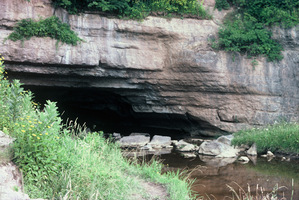 | Back to e-WV
| Back to e-WV
 The West Virginia Encyclopedia
The West Virginia Encyclopedia
 | Back to e-WV
| Back to e-WV
 The West Virginia Encyclopedia
The West Virginia Encyclopedia

Gandy Creek sinks under the earth at a blind valley south of Yokum Knob in eastern Randolph County. The stream then flows northeast through a large cave for about three-quarters of a mile and emerges from one of the cave’s two north entrances. The cave was described in 1872 by David Hunter Strother, writing under the pen name of ‘‘Porte Crayon’’ in an article for Harper’s Magazine. This account from a visit in 1854, although romanticized and fanciful, provides a remarkably accurate description of the cave itself, and his sketch of the south entrance shows the picturesque opening in the side of the hill very much as it appears today. A history of the cave by Jack Preble describes a bloody Civil War skirmish at the north exit on March 20, 1864.
The Sinks may be the most visited wild cave in West Virginia. The cave takes the entire flow of Gandy Creek and can flood suddenly following rain. An article in the Saturday Evening Post in 1941 by Clay Perry recounts the story of four cavers who were trapped in the cave for five hours. The cave is at the base of the Greenbrier Group limestones (Mississippian age) and has about 1.5 miles of surveyed passage.
Written by William K. Jones
Preble, Jack. The Sinks of Gandy Creek. Parsons: McClain, 1969.
Strother, David H. The Mountains. Harper's 45, 1872.
Strother, David H. The Mountains. Harper's 46, 1872.
Strother, David H. "," in Jim Comstock, ed, Porte Crayon Sampler. Richwood: 1974.